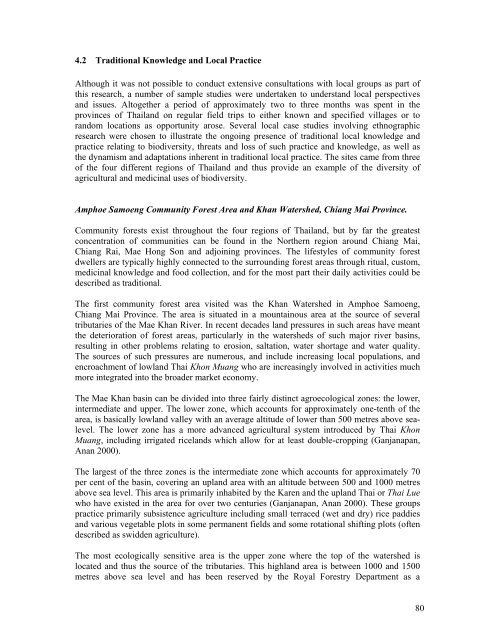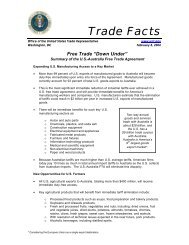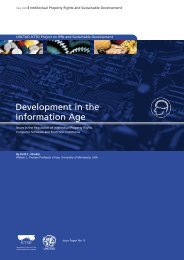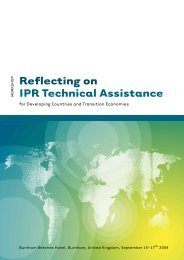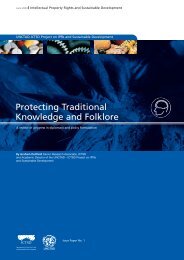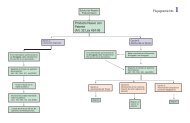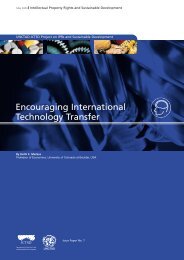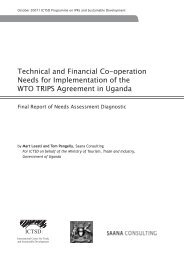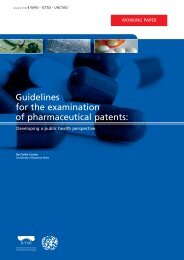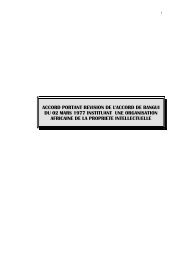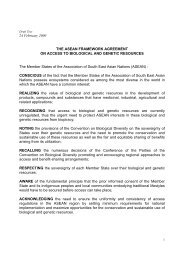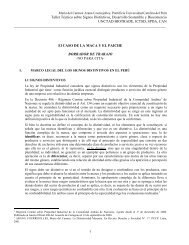Governance and Micropolitics of Traditional ... - IPRsonline.org
Governance and Micropolitics of Traditional ... - IPRsonline.org
Governance and Micropolitics of Traditional ... - IPRsonline.org
Create successful ePaper yourself
Turn your PDF publications into a flip-book with our unique Google optimized e-Paper software.
4.2 <strong>Traditional</strong> Knowledge <strong>and</strong> Local Practice<br />
Although it was not possible to conduct extensive consultations with local groups as part <strong>of</strong><br />
this research, a number <strong>of</strong> sample studies were undertaken to underst<strong>and</strong> local perspectives<br />
<strong>and</strong> issues. Altogether a period <strong>of</strong> approximately two to three months was spent in the<br />
provinces <strong>of</strong> Thail<strong>and</strong> on regular field trips to either known <strong>and</strong> specified villages or to<br />
r<strong>and</strong>om locations as opportunity arose. Several local case studies involving ethnographic<br />
research were chosen to illustrate the ongoing presence <strong>of</strong> traditional local knowledge <strong>and</strong><br />
practice relating to biodiversity, threats <strong>and</strong> loss <strong>of</strong> such practice <strong>and</strong> knowledge, as well as<br />
the dynamism <strong>and</strong> adaptations inherent in traditional local practice. The sites came from three<br />
<strong>of</strong> the four different regions <strong>of</strong> Thail<strong>and</strong> <strong>and</strong> thus provide an example <strong>of</strong> the diversity <strong>of</strong><br />
agricultural <strong>and</strong> medicinal uses <strong>of</strong> biodiversity.<br />
Amphoe Samoeng Community Forest Area <strong>and</strong> Khan Watershed, Chiang Mai Province.<br />
Community forests exist throughout the four regions <strong>of</strong> Thail<strong>and</strong>, but by far the greatest<br />
concentration <strong>of</strong> communities can be found in the Northern region around Chiang Mai,<br />
Chiang Rai, Mae Hong Son <strong>and</strong> adjoining provinces. The lifestyles <strong>of</strong> community forest<br />
dwellers are typically highly connected to the surrounding forest areas through ritual, custom,<br />
medicinal knowledge <strong>and</strong> food collection, <strong>and</strong> for the most part their daily activities could be<br />
described as traditional.<br />
The first community forest area visited was the Khan Watershed in Amphoe Samoeng,<br />
Chiang Mai Province. The area is situated in a mountainous area at the source <strong>of</strong> several<br />
tributaries <strong>of</strong> the Mae Khan River. In recent decades l<strong>and</strong> pressures in such areas have meant<br />
the deterioration <strong>of</strong> forest areas, particularly in the watersheds <strong>of</strong> such major river basins,<br />
resulting in other problems relating to erosion, saltation, water shortage <strong>and</strong> water quality.<br />
The sources <strong>of</strong> such pressures are numerous, <strong>and</strong> include increasing local populations, <strong>and</strong><br />
encroachment <strong>of</strong> lowl<strong>and</strong> Thai Khon Muang who are increasingly involved in activities much<br />
more integrated into the broader market economy.<br />
The Mae Khan basin can be divided into three fairly distinct agroecological zones: the lower,<br />
intermediate <strong>and</strong> upper. The lower zone, which accounts for approximately one-tenth <strong>of</strong> the<br />
area, is basically lowl<strong>and</strong> valley with an average altitude <strong>of</strong> lower than 500 metres above sealevel.<br />
The lower zone has a more advanced agricultural system introduced by Thai Khon<br />
Muang, including irrigated ricel<strong>and</strong>s which allow for at least double-cropping (Ganjanapan,<br />
Anan 2000).<br />
The largest <strong>of</strong> the three zones is the intermediate zone which accounts for approximately 70<br />
per cent <strong>of</strong> the basin, covering an upl<strong>and</strong> area with an altitude between 500 <strong>and</strong> 1000 metres<br />
above sea level. This area is primarily inhabited by the Karen <strong>and</strong> the upl<strong>and</strong> Thai or Thai Lue<br />
who have existed in the area for over two centuries (Ganjanapan, Anan 2000). These groups<br />
practice primarily subsistence agriculture including small terraced (wet <strong>and</strong> dry) rice paddies<br />
<strong>and</strong> various vegetable plots in some permanent fields <strong>and</strong> some rotational shifting plots (<strong>of</strong>ten<br />
described as swidden agriculture).<br />
The most ecologically sensitive area is the upper zone where the top <strong>of</strong> the watershed is<br />
located <strong>and</strong> thus the source <strong>of</strong> the tributaries. This highl<strong>and</strong> area is between 1000 <strong>and</strong> 1500<br />
metres above sea level <strong>and</strong> has been reserved by the Royal Forestry Department as a<br />
80


